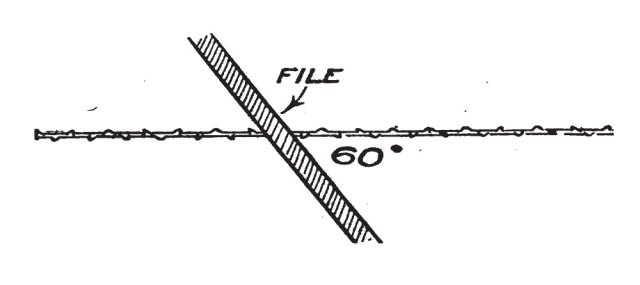
This is an excerpt from “The Woodworker: The Charles H. Hayward Years: Volume I” published by Lost Art Press.
A reader has sent us a sketch of the teeth of a saw he wishes to sharpen. These are the farmer’s American or lightning type, and are intended for cross-cutting. He enquires the correct bevel and set to give the teeth. We give the reply here as it will probably interest other readers.
The sharpening is rather different from that of the ordinary cross-cut handsaw. In the latter the file is held at an angle varying from 45 to 60 degrees with the line of the blade and is kept perfectly horizontal. The back of one tooth and the front of the next are sharpened in one operation. In the lightning tooth one side of one tooth only is sharpened at a time. There are three distinct operations, of which the first is gulleting (A, Fig. 1), in which a special file with rounded edge is used. In this the file is held at right angles with the blade and perfectly horizontal. The filing of the long edge of the end teeth follows and for this the near end of the file is dropped so that it points upwards at an angle somewhere in the region of 45 degrees and at about 80 degrees with the line of the teeth. The exact angles cannot be given because it is largely a matter of individual handling. However, the bevel at which to aim is one in which the teeth are in alignment with an ordinary three-cornered file when rested horizontally across them at 60 degrees, as in Fig. 2.

The professional sharpener does not need to do this, but it is a handy test for the inexperienced man. Fig. 1 at B shows how the long edge is sharpened. The short edges of the end teeth and the middle teeth follow, and for these an exactly similar process is followed (see C). If, after several sharpenings, the teeth tend to get out of shape, they should be corrected by running the file straight across at right angles and horizontal. When true the sharpening as already described follows.
With regard to setting (this of course precedes sharpening), since lightning tooth saws are generally used for green wood which is liable to cling, a full set is desirable. If an impression of the points of the teeth is taken on paper it will generally be found that they will register about twice the thickness of the blade. D shows about the right amount of set. As in all other saws, the set should never extend more than halfway down the depth of the tooth (E).
— MB


Interesting. I have a Sandvik metal bow saw with that tooth pattern. Now I know how to tackle it (if it’s not been hardened?).